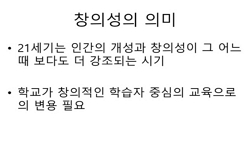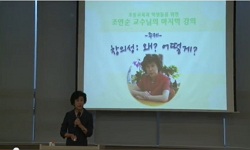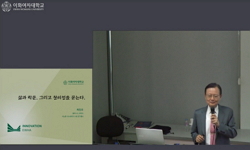미술사 연구에서 “독창성(originality)”은 오랫동안 중요한 문제로 여겨져왔다. 예술의 독창성에 대한 이론적 탐구는 미술사 보다는 미학에서 주로 이루어졌다. 미학에서 독창성은 창의성(cre...
http://chineseinput.net/에서 pinyin(병음)방식으로 중국어를 변환할 수 있습니다.
변환된 중국어를 복사하여 사용하시면 됩니다.
- 中文 을 입력하시려면 zhongwen을 입력하시고 space를누르시면됩니다.
- 北京 을 입력하시려면 beijing을 입력하시고 space를 누르시면 됩니다.
https://www.riss.kr/link?id=A100123476
- 저자
- 발행기관
- 학술지명
- 권호사항
-
발행연도
2014
-
작성언어
Korean
-
주제어
독창성 ; 창의성 ; 모방 ; 복제 ; 기(奇) ; 동기창 ; 김정희 ; 다펀유화촌 ; Originality ; Creativity ; Mimesis ; Copy ; Qi ; Dong Qichang ; Kim Ch?ng-h?i ; Dafen Oil Painting Village
-
등재정보
KCI등재
-
자료형태
학술저널
-
수록면
255-280(26쪽)
- 제공처
-
0
상세조회 -
0
다운로드
부가정보
국문 초록 (Abstract)
미술사 연구에서 “독창성(originality)”은 오랫동안 중요한 문제로 여겨져왔다. 예술의 독창성에 대한 이론적 탐구는 미술사 보다는 미학에서 주로 이루어졌다. 미학에서 독창성은 창의성(creativity)과 더불어 예술의 기본 특성으로 간주되기에 이에 대한 철학적이고 인식론적 접근이 시도되었다. 반면 미술사에서는 이를 본격적으로 다루기보다는 역사 속에서 구체적인 사례를 연구하면서 개별 작가나 작품에 대하여 독창성을 언급하는 방식이었다. 이 글에서는 서양과 동양의 미술사에서 독창성이란 문제가 어떻게 다루어졌는지를 비교해 보고, 현재 전개되고 있는 미술의 경우를 예로 들면서 독창성이 어떤 의미를 지니는 지를 살펴본다. 미술에서 완전한 새로움을 기대하는 것은 모더니즘의 유산인데, 이를 다시 생각해 보는 것은 중요한 의미를 지닌다.
서양 고대인들에게 예술은 창조성과는 거리가 먼 것이었다. 예술가는 아름다움을 만들어 내는 것이 아니라 발견해 내는 역할을 담당하는 것이었다. 따라서 모방을 뜻하는 그리스어 “미메시스”는 오랫동안 중요한 개념이 되었다. 중세에는 무(無)의 상태에서 유(有)를 만들어내는 창조란 것은 신의 영역에 속하는 것을 가리키게 되었고, 인간에게는 해당되지 않는 것이었다. 이렇게 미술가는 창조하는 것이 아니라 모방하는 것이라는 관점은 르네상스 시대에도 지속되었고, 모방이론의 중요성은 정점에 도달했다.
창조와 독창성에 대한 인식의 변화는 낭만주의가 본격적으로 등장한 19세기에 이루어졌다. 고전주의와 달리 낭만주의는 기계적 모방에 의한 복제를 낮게 평가했고, 예술을 단순한 모방을 넘어서는 창조라고 인식하기 시작했다. 낭만주의에서는 자아만이 독창성의 근원이 된다. 낭만주의와 마찬가지로 모더니즘 역시 이미 존재하고 있는 관습을 반복하지 않고, 기존 위계질서를 전복시키려고 한다.
서양 미술의 사례를 통해서 살펴보았을 때 독창성이란 사회적으로 구성되는 것이라고 할 수 있다. 사회적, 문화적, 경제적, 제도적, 역사적, 성적 조건에 따라 독창성을 다르게 규정할 수 있는 것이다.
한편 동양의 고대 화론을 살펴보면 독창성과 관련하여 지속적으로 논의해 왔음을 발견할 수 있다. 처음에 중요했던 것은 “일격(逸格)”이라는 개념이다. 신품(神品), 묘품(妙品), 능품(能品)으로 그림의 품격을 나누었고, 그 밖에 통상적인 법에 구애받지 않는 것으로서 일격을 두었다. 창의적이고 독창적인 요소를 별개의 범주로 구분한 것이다.
이후에 독창성에 해당하는 용어로 많이 사용된 것은 낯설다는 “괴(怪)”, 다르다는 “이(異)”, 기묘하다는 “기(奇)” 등이 있다. 특히 명말청초에 해당하는 17세기에는 기(奇)가 많이 사용되었다. 기(奇)는 기존의 분류에 속하지 않고, 이전과는 확연하게 다르며, 화가 자신만의 특징을 갖추고 있다는 의미로 쓰였음을 알 수 있다. 동기창(董其昌, 1555-1636)은 “정(正)”과 대비되는 것으로 “기(奇)”를 중요시했고, 기묘함의 예술적 가치에 대하여 긍정적이었다. 조선에서도 강세황(姜世晃, 1712-1791)이나 김정희(金正喜, 1786-1856)의 경우에 “기(奇)”를 강조했다.
21세기에 독창성의 문제를 다시 생각해 보게 만드는 좋은 사례를 중국선전(深?)의 다펀유화촌(大芬油畵村)에서 찾아 볼 수 있다. 이곳에서는 연간 500만점 이상의 유화를 제작하여 수출하고 있다. 대부분이 서양미술사에서 유명한 작품들의 복제화로서 다펀유화촌의 사례는 독창성에 대한 오래된 고정관념을 깨준다.
다국어 초록 (Multilingual Abstract)
In the field of art history, “originality” has long been an important issue. A theoretical examination of the creativity of art has been taken mainly in aesthetics rather than in art history. Aestheticians considered originality together with crea...
In the field of art history, “originality” has long been an important issue. A theoretical examination of the creativity of art has been taken mainly in aesthetics rather than in art history. Aestheticians considered originality together with creativity as the basic characteristics of art, and they attempted philosophical and epistemological approach. On the contrary, art historians have tried to explain specific cases about the originality of the individual artists and artworks.
Searching for the newness in art is a crucial feature of modernism, and it is a significant task to rethink the myth of originality. This article based on a comparative point of view explores how the East and the West deal with the issue of originality in art history.
The ancient Western people considered that art has nothing to do with creativity because they believed that artists are not to create but to find beauty. “Mimesis” meaning imitation in Greek was an important concept for a long time. In the Middle Ages, people believed that the creation which means making something from nothing is the realm of God. The idea that artists’ mission is not creating but imitating continued in the Renaissance period.
The perception of originality and creativity began to change with the emergence of Romanticism in the 19th century. Unlike Classicism, Romanticism devaluated a mechanical imitation as replication and recognized art as creation beyond mere imitation. Only the self is the source of creativity in Romanticism. Likewise, Modernism also refused customary repetition and tried to overthrow the hierarchy of art.
The thorough examination of the ancient East Asian art theory reveals that the concept of originality has a long tradition. In the early period, the term of “untrammeled (yil 逸格)” played an important role in the discourse of originality. The categories of inspired (sin 神品), excellent (myo 妙品) and capable (n?ng 能品) are established. Beside them, the “untrammeled” is listed. It is not placed blow but considered as an independent category with its creative and innovative elements.
In the later periods, originality is used in several different words that are “strange (koe 怪)”, “uncommon (yi 異)”, “original (ki 奇)” and so on. In the 17th century, ki (Ch. qi 奇) gained popularity. Ki does not belong to the traditional classification and means evidently different with its own sense of strangeness. Dong Qichang (董其昌, 1555-1636) highly valued ki as contrasted with “proper (Ch?ng 正).” To him, ki was positive about the artistic creation. Korean literati painters, such as Kang Se-hwang (姜世晃, 1712-1791) and Kim Ch?ng-h?i (金正喜, 1786-1856), also emphasized ki.
In the 21st century, Dafen Oil Painting Village in Shenzhen becomes a good case to think of originality. Most of the famous works of Western art history are copied here and exported to all over the world. More than five million paintings are produced every year. The Dafen case raises many important questions for creativity and breaks old stereotypes of copying.
From the above examples, it is clear that creativity is being socially constructed, and originality is defined differently according to the prescribed social, cultural, institutional and gender conditions.
목차 (Table of Contents)
- Ⅰ. 머리말
- Ⅱ. 서양미술사에서의 창조와 모방
- Ⅲ. 동양미술사에서의 창조와 모방
- Ⅳ. 21세기 미술의 창조와 모방
- Ⅴ. 맺음말
- Ⅰ. 머리말
- Ⅱ. 서양미술사에서의 창조와 모방
- Ⅲ. 동양미술사에서의 창조와 모방
- Ⅳ. 21세기 미술의 창조와 모방
- Ⅴ. 맺음말
- 참고문헌
- 국문초록
- Abstract
1 한국미술의 자생성 간행위원회, "한국미술의 자생성" 한길아트, 1999
2 양정무, "풍경화의 모순, 현대미술사학의 위기?" 美術史學 15 : 247 ~ 272, 2001
3 정혜인, "추사(秋史) 김정희(金正喜)의 청대(淸代) 서파(書派) 수용과 절충" 美學(미학) (73) : 1 ~ 41, 2013
4 서복관, "중국예술정신" 동문선, 1990
5 정혜린, "조선 후기 예술론의 전개" 서울대출판부 : 623 ~ 646, 2008
6 조인수, "전통, 근대가 만들어낸 또 하나의 권력" 인물과 사상 : 122 ~ 153, 2010
7 이주형, "인문학으로서의 미술사학" 미술사학연구 268 (268) : 117 ~ 138, 2010
8 이순예, "예술과 천재" 인문논총 (54) : 105 ~ 130, 2005
9 진휘연, "아방가르드, 네오-아방가르드, 새로움의 정치학: 아방가르드 미술론의 역사와 전망" 현대미술사연구 (34) : 153 ~ 178, 2013
10 이지은, "시각문화연구와 미술사의 쟁점들 시각성과 이미지의 문제를 중심으로" 미술사학 20 : 79 ~ 103, 2006
1 한국미술의 자생성 간행위원회, "한국미술의 자생성" 한길아트, 1999
2 양정무, "풍경화의 모순, 현대미술사학의 위기?" 美術史學 15 : 247 ~ 272, 2001
3 정혜인, "추사(秋史) 김정희(金正喜)의 청대(淸代) 서파(書派) 수용과 절충" 美學(미학) (73) : 1 ~ 41, 2013
4 서복관, "중국예술정신" 동문선, 1990
5 정혜린, "조선 후기 예술론의 전개" 서울대출판부 : 623 ~ 646, 2008
6 조인수, "전통, 근대가 만들어낸 또 하나의 권력" 인물과 사상 : 122 ~ 153, 2010
7 이주형, "인문학으로서의 미술사학" 미술사학연구 268 (268) : 117 ~ 138, 2010
8 이순예, "예술과 천재" 인문논총 (54) : 105 ~ 130, 2005
9 진휘연, "아방가르드, 네오-아방가르드, 새로움의 정치학: 아방가르드 미술론의 역사와 전망" 현대미술사연구 (34) : 153 ~ 178, 2013
10 이지은, "시각문화연구와 미술사의 쟁점들 시각성과 이미지의 문제를 중심으로" 미술사학 20 : 79 ~ 103, 2006
11 전영백, "서양의 현대 미술비평 동향 연구: 1980년대 이후 영·미권 미술사 및비평담론의 주요 화두를 중심으로" 미술사연구 (27) : 447 ~ 484, 2013
12 타타르키비츠, "미학의 기본 개념사" 미술문화, 1999
13 박소현, "미술사의 소비" 미술사학보 (38) : 101 ~ 134, 2012
14 전동호, "미술사와 시각문화의 정체성" 미술사와 시각문화 (4) : 8 ~ 31, 2005
15 조인수, "물질문화연구와 동양미술" 미술사와 시각문화 (7) : 8 ~ 37, 2008
16 갈로, "中國繪畵理論史" 미진사, 1989
17 박용만, "『剡社篇』의 자료적 특징과 문학사적 의의" 성호학보 (11) : 145 ~ 177, 2012
18 Wong, Winnie Won Yin, "Van Gogh on Demand : China and the Readymade" The University of Chicago Press, 2014
19 Boden, Margaret, "The Routledge Companion of Aesthetics" Routledge : 477 ~ 488, 2005
20 Alperson, Philip, "The Oxford Handbook of Aesthetics" Oxford University Press : 245 ~ 257, 2005
21 Shiff, Richard, "Encyclopedia of Aesthetics" Oxford Universitiy Press : 408 ~ 413, 1998
22 Burnett, Katharine, "Dimensions of Originality : Essays on Seventeenth-century Chinese Art Theory and Criticism" The Chinese University Press, 2013
23 Shiff, Richard, "Critical Terms for Art History" The University of Chicago Press : 145 ~ 159, 2003
24 Elkins, James, "Art History Versus Aesthetics" Routledge, 2006
25 Wong, Winnie Won Yin, "After the Copy: Creativity, Originality and the Labor of Appropriation, Dafen Village, Shenzhen, China (1989-2010)" MIT, 2010
동일학술지(권/호) 다른 논문
-
- 한국미술사교육학회
- 이한순(토론자)
- 2014
- KCI등재
-
- 한국미술사교육학회
- 김재열
- 2014
- KCI등재
-
- 한국미술사교육학회
- 우정아(Woo, Jungah)
- 2014
- KCI등재
-
「솔 르윗의 <월 드로잉>과 개념미술의 오리지낼리티」에 대한 질의
- 한국미술사교육학회
- 조현정
- 2014
- KCI등재






 DBpia
DBpia







